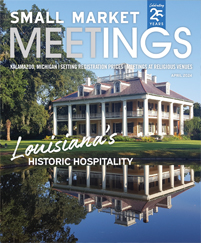In recent surveys, 75 percent of meeting organizers said they had not prepared a crisis communication strategy or a contingency option for their event.
Like all of us, Lynne Breil is navigating through the uneasy seas of a global pandemic. The business etiquette expert has shifted from speaking at conferences and teaching in classrooms to making virtual presentations to businesspeople and students from her home office. She’s found that like the real world, the virtual world benefits from polish, professionalism and, of course, politeness. Here, she shares some insights based on her experiences and her expertise.
For more information about Breil and her company — The Professional Edge — or her new book, “Best in Class: Etiquette and People Skills for Your Career,” visit theprofessionaledgeinc.com.
Relay the Rules
Being a meeting planning professional during a pandemic requires being specific about what is required of participants, said Breil. People who attend in-person gatherings will come from different places, both geographically and philosophically. That’s why meeting planners need to clearly spell out the ground rules and describe the consequences of ignoring event safety protocols, she said.
“Planners have to be direct in what they are asking people to do,” she said. If masks are required, back up the decision “with data from trusted resources,” or point out that “we are still in crisis mode, so masks will be required,” she said. Then, consequences must be enforced. Everyone involved in a conference, from hotel or convention staff to speakers and vendors, should receive safety guidelines.
The same goes for virtual meetings. Let everyone know ahead of time how the meeting will work. For example, should they mute their video and audio, or leave it on? Should they ask questions along the way, or will there be a dedicated Q&A?
Don’t Get Sloppy
You’re already spending a lot of time in virtual meetings, and that’s not likely to end soon. Breil has been teaching online classes since the pandemic began, and her tips can help planners look as professional as possible in virtual meetings. If you are running a lot of virtual meetings, you might want to send tips like these to attendees beforehand.
In virtual meetings, dress as you would for a professional meeting, but, Breil said, with extra thought to what might be distracting on video; for example, stripes and other busy patterns, flashy necklaces and jangly earrings. Avoid disappearing into the background, she said, by wearing clothing that contrasts with it, such as a dark blue shirt against a white wall.
Pick a Professional Setting
As you choose a place to sit for your virtual meeting, consider what’s in front of and behind you. Sitting with a window or lamp behind you will make you look dark and shadowy, like a crime boss in a witness protection program. Better to have a light source in front. Choose a plain uncluttered background. As Breil points out, you want people to focus on what you are saying, not the rows of trophies or family photos on the shelves behind you. Tech security experts warn that cybercriminals can use items in your background, like a label on a shipping box — to grab personal information. It’s fine to stage your virtual meeting setting a bit, Breil says. A green plant in the background is neutral and pleasant. And “while no one expects you to have a conference room that looks like a corporate office,” she said, at least make your bed if you have to Zoom from the bedroom. Keep your screen at eye level; otherwise, everyone sees you from a most unflattering angle.
Replace Handshakes With Waves and Nods
Some say handshakes will now be frowned upon forever; others say we’ll never completely let go of this greeting. Alternatives like elbow bumps have been suggested, but they prove problematic, Breil pointed out, as they break social distancing guidelines and involve “elbows that we sneeze into.” Breil proposes a manner of greeting people that encompasses three qualities that any introduction should include — respect, authenticity and connection — but with social distancing.
“Fold your right hand to your heart, bow slightly and look the person you are greeting in the eye,” she recommends. The Emily Post Institute says now is the time to perfect a variety of waves for various occasions: a professional version, a wave for a Zoom meeting with peers, a really-miss-you and would-love-to-hug-you wave for close friends and family.
Speak Up
The pandemic has taken a toll on human connection. We can’t hug or shake hands. Masks hide smiles and muffle voices; virtual meetings allow us to see and hear one another, but the body language that adds depth to conversations is often missing. That’s why energizing your expression and your voice is so important in virtual encounters and even face-to-face meetings where masks are being worn, according to Breil.
“When you take away an audience, people’s energy drops and the presenter’s energy drops. You have to give it 30% more,” said Breil. Think about how much more expressive you are when you read a book to a young child, she said, and add some of that excitement and energy to your voice and to your facial expressions.











